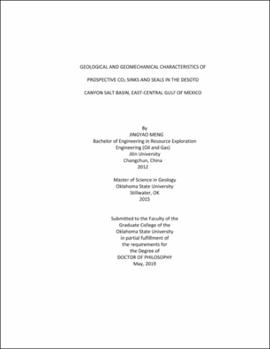| dc.contributor.advisor | Pashin, Jack C. | |
| dc.contributor.author | Meng, Jingyao | |
| dc.date.accessioned | 2023-08-21T19:42:39Z | |
| dc.date.available | 2023-08-21T19:42:39Z | |
| dc.date.issued | 2019-05 | |
| dc.identifier.uri | https://hdl.handle.net/11244/338891 | |
| dc.description.abstract | Subsurface geologic storage of CO₂ can play a major role in offsetting greenhouse gas emissions, and offshore storage in the DeSoto Canyon Salt Basin in the east-central Gulf of Mexico may be a viable solution due to large storage capacity (~150) Gt in Cretaceous-Cenozoic sandstone. The Cretaceous reservoirs are overlain by thick sections of tight mudrock, limestone, and chalk, which form regionally extensive seals. Understanding the structural styles and geomechanical properties of the associated reservoir rocks and seals is therefore essential for safe and effective CO₂ storage. | |
| dc.description.abstract | The structural framework in the Mississippi-Alabama-Florida shelf of the Gulf of Mexico includes the DeSoto Canyon Salt Basin, the Middle Ground Arch, and the Tampa Embayment. The Central DeSoto Canyon Salt Basin is structurally complex due to the presence of peripheral faults, salt pillows, salt rollers, and salt diapirs. Multiple faults associated with the peripheral faults and salt pillows displace the potential Cretaceous reservoirs and seal intervals. Elongation of borehole breakouts is aligned with the minimum horizontal compressive stress (Shₘᵢₙ), which tends to be oriented northeast-southwest. Vertical reservoir stresses are influenced by rock and fluid density. Lithostatic and hydrostatic stress each have a power-law relationship to depth. The average lithostatic stress (Sv) gradient is ~21.4 kPa/m. Hydrostatic pressure gradient increases with brine density to a maximum of ~12.2 kPa/m. Geometric mean of the Shmin-depth values corresponds to an effective Shmin–effective Sv quotient of ~0.5. Reactivation tendency and seal analysis of the major faults shows that while the slip tendency is small, the dilation tendency and potential for cross-formational flow is relatively high, particularly where reservoir strata in the footwalls are juxtaposed with sealing strata in the hanging walls. Geomechanical analysis of reservoir and seal strata indicates that prospective reservoirs and associated seals are stable if injection pressure does not exceed fracture pressure. | |
| dc.description.abstract | Favorable CO₂ injection sites are available throughout the stable shelf areas of the DeSoto Canyon Salt Basin, where faults with high dilation tendency are absent above the Jurassic section. Future research should focus on further geomechanical, pressure, and flow simulation of the potential reservoirs and associated seals. | |
| dc.format | application/pdf | |
| dc.language | en_US | |
| dc.rights | Copyright is held by the author who has granted the Oklahoma State University Library the non-exclusive right to share this material in its institutional repository. Contact Digital Library Services at lib-dls@okstate.edu or 405-744-9161 for the permission policy on the use, reproduction or distribution of this material. | |
| dc.title | Geological and geomechanical characteristics of prospective CO₂ sinks and seals in the Desoto Canyon Salt Basin, east-central Gulf of Mexico | |
| dc.contributor.committeeMember | Laó Dávila, Daniel A. | |
| dc.contributor.committeeMember | Ismail, Ahmed | |
| dc.contributor.committeeMember | Nygaard, Runar | |
| dc.contributor.committeeMember | Bikkina, Prem | |
| osu.filename | Meng_okstate_0664D_16170.pdf | |
| osu.accesstype | Open Access | |
| dc.type.genre | Dissertation | |
| dc.type.material | Text | |
| dc.subject.keywords | fault analysis | |
| dc.subject.keywords | geological storage of CO₂ | |
| dc.subject.keywords | geomechanics | |
| dc.subject.keywords | Gulf of Mexico | |
| dc.subject.keywords | stress field | |
| dc.subject.keywords | structural framework | |
| thesis.degree.discipline | Geology | |
| thesis.degree.grantor | Oklahoma State University | |
